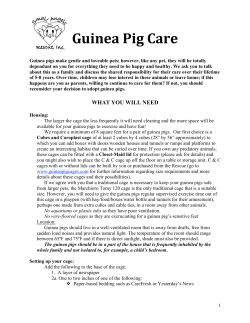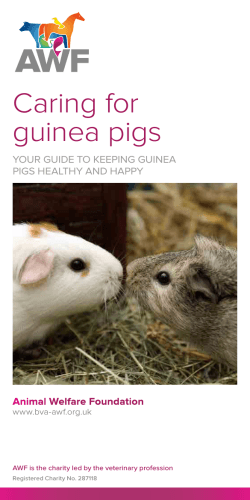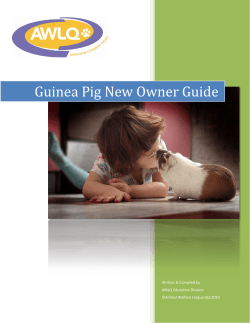
Guinea Pigs
Small Animal Care Series The British Columbia Society for the Prevention of Cruelty to Animals Guinea Pigs The guinea pig or cavy (pronounced kay-vee) is a member of the rodent family, closely related to the chinchilla and the porcupine. In the grasslands of Peru, wild guinea pigs live in family groups of five to 10 individuals. Being a prey species, they have very sensitive hearing and a good sense of smell. When startled, they respond quickly by running for cover. They are most active at dawn and dusk, feeding on grasses, seeds, fruits and roots. A few hundred years ago when European explorers traveled to South America, they returned home with guinea pigs. Because of their affectionate nature, they soon became popular pets in both Europe and North America. Today, there are more than 13 breeds of guinea pigs, with many different coat types and multiple colour combinations. There are even two hairless varieties: “skinny pigs,” who only have hair on their heads and lower legs, and “Baldwins,” who are born with hair but lose it all by the time they are weaned as babies. Like people, each guinea pig is unique. . Some are outgoing, while others are Either way, guinea pigs make wonderful companions. They are gentle animals who rarely nip, and are generally quiet – though they do have a range of calls and chatters, especially at mealtimes! Guinea pigs are known to grunt, squeak, wheek and chirp. They will even make “purring” sounds when they are being petted and feeling content on your lap. The ideal guardian for a guinea pig is someone who is willing to provide a large, interesting habitat, as well as plenty of out-of-cage exercise, fresh food and water, and of course some quiet lap time. Are you that someone? Guinea Pig Stats: Origin: South America Status: Domesticated over 5,000 years ago Life Span:Usually five to seven years Size: Weigh up to about 1 kg and measure 20 to 30 cm in length Coat: Comes in a variety of “styles,” from short and straight to long and curly Colour: Many different colours and patterns, like lemon yellow or “Dalmatian” (black spots on white) 10 Care tips for Guinea Pigs Here are just some of the things you need to know to be the best guinea pig guardian! The pet care section of the BC SPCA website – spca.bc.ca – has additional information on guinea pig care. Healthy pigs Veg out! Guinea pigs are herbivores, meaning they only eat plants. Feed a small amount of fresh fruits and vegetables high in vitamin C – peppers, parsley, spinach, kale and papayas are all good. Vitamin C is important for guinea pig health. Be familiar with how your guinea pigs normally look and behave, and take them to the vet as soon as you notice anything unusual, like diarrhea, breathing difficulties, or loss of appetite. Pellet food too! Be sure to feed pellets specific to guinea pigs because they’re fortified with vitamin C. Hey, don’t forget hay! Let your guinea pigs munch away on Timothy hay to their heart’s content! Hay helps with digestion. Avoid alfalfa, though – it’s too rich for most guinea pigs. Wood is good To help wear down their evergrowing front teeth, provide your guinea pigs with chewing items such as apple or aspen branches. Just make sure the branches come from trees that haven’t been treated with any chemicals. Cavy condos Guinea pigs need a living area that is at least 65 cm by 65 cm per guinea pig, with walls about 30 cm high. Since they don’t climb or jump, the enclosure can be open on top – unless you also happen to have a cat or a dog at home! The cage can be made out of wood, metal or plastic. The bottom should be flat and solid, not mesh or wire, which can hurt their feet. Room to run Guinea pigs require exercise and will happily romp around a room that has been cleared of hazards such as electric cords, cats or dogs and poisonous plants. They love to run along walls and hide under furniture. You should let your guinea pigs have time out of their habitat every day in a safe, enclosed area. Spa treatment Guinea pigs need to have their nails trimmed every four to six weeks. Have an adult do this! Nail trimming can be tricky because if you cut them too short, the nails can bleed and be painful. Love and attention Guinea pigs like to be cuddled, but must be handled gently and carefully. Always pick up your guinea pig with two hands: one hand under her hind end and the other around her chest. Hold her while you are sitting down, preferably on the floor, so that she will not be injured if she does fall. Long-haired guinea pigs need to have their hair brushed regularly. And though guinea pigs do groom themselves, you can periodically give your guinea pig a bath if he is smelly or greasy. Use warm water and a mild pet shampoo. Make sure you keep his face dry and rinse out all of the shampoo. Dry him off with a towel. Buddy up! Guinea pigs love company. Two can live together as long as they are the same sex and have a large enough living space. Never keep males and females together, even for a short period (unless they are neutered or spayed)! Thirsty pigs Guinea pigs should always have fresh water available to them through a sipper bottle. Change the water daily and clean the bottle with soap and water once a week. Add a jungle gym Cover the cage floor with aspen wood shavings or CareFRESH® (bedding made from recycled paper). Do not use cedar or pine shavings because they can cause health problems. Keep the cage in an area protected from cold drafts and direct sunlight. Scoop soiled shavings daily and clean the entire cage at least once a week with soap and water. A clean, dry cage will help keep your guinea pigs healthy. Within the cage, add small wooden or plastic houses, as well as cardboard or plastic tubes large enough for your guinea pigs to run through. These will help prevent boredom and make them feel secure. Small Animal Care Series The British Columbia Society for the Prevention of Cruelty to Animals , ... ahhh ! ir fresh a But wait, there’s more! This booklet provides basic care information. Please visit spca.bc.ca/animalcare for more detailed information on guinea pig care. Consult your veterinarian, as well as one of the many care books available at book stores, pet supply stores or your public library. Look for ones that describe nutrition, health issues, grooming and guinea pig behaviour. Home, sweet home Bring on the yummy ! veggies The cages sold at most pet supply stores don’t provide guinea pigs with much space to eat, sleep, play and go to the bathroom. Cramped living quarters can cause your guinea pigs to become bored and frustrated. Read our step-by-step guide to building a large, inexpensive habitat on our guinea pig care section online. The bigger your habitat, the happier your guinea pigs will be! The great outdoors Guinea pigs should never be kept outdoors permanently, but when the weather is nice, try taking them outside for some exercise. Place your guinea pigs out Make the on untreated grass inside a pen or under a wire cage top. Don’t leave them unattended! Be sure they have a small shelter they can retreat to for shade and hiding. You can add tubes and boxes to make it more interesting, but many guinea pigs are content just to munch away on grass and dandelion leaves! The guinea pig guardian pledge As their guardian, you are responsible for your guinea pigs’ health and well-being. You should make sure: 1. They never go hungry or thirsty; 2. They are taken to the vet when they are sick or injured; Not much room 3. They are not afraid all the time; to move in here! 4. They are comfortable in their surroundings; 5. They are free to behave like guinea pigs! For more information on providing these “Five Freedoms,” check out spca.bc.ca/animalcare. your first adoption option! Visit spca.bc.ca to view all adoptable guinea pigs.
© Copyright 2025



















